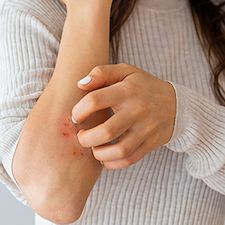Article
Skin Picking, Other Body-Focused Repetitive Behaviors Improved by Habit Replacement
Author(s):
This new research highlights the value of habit replacement intervention, supported by the fact that apparent low usefulness/efficacy of other methods for patients can often manifest in poorer retention.

Habit replacement may be a viable and effective self-help approach to address body-focused repetitive behaviors (BFRBs) such as skin picking and nail biting, according to recent findings.1
These findings resulted from a new study conducted to assess the use of a newly-designed self-help intervention for patients known as habit replacement for BFRBs. These behaviors (eg, skin picking) are prevalent among patients but known to be both underdiagnosed and undertreated.2
The study was carried out in order to compare this method to others, and it was authored by Steffen Moritz, PhD, from the Department of Psychiatry and Psychotherapy at the University Medical Center Hamburg-Eppendorf in Germany.
“The present trial was set up as a proof-of-concept trial awaiting studies with more rigorous methodology in the event of positive results,” they wrote. “We tested habit replacement against a wait-list control (WL) condition.”
Background and Findings
The investigators executed a controlled online trial which focused on investigating the effectiveness of habit replacement therapy for individuals with BFRBs such as picking at skin, nail biting, trichotillomania, and lip-cheek biting. Participants aged 18 to 80 years, with no history of schizophrenia or acute suicidality, were recruited by the team via social media channels.
A total of 481 individuals initially participated in the trial, but 213 were excluded by the investigators due to noncompletion of the pre-assessment. The final sample the team used included 268 individuals who became randomly assigned to either the habit replacement arm of the study (n=134) or the waitlist arm (n=134).
The habit replacement group specifically was encouraged by the research team to use gentle circling movements, as described in a video and manual demonstration.
The team’s primary outcome measure was the Generic BFRB Scale-45 (GBS-45), which was used to assess various BFRBs. Their secondary outcome measures involved the WHOQOL-BREF global quality-of-life item (QOL) as well as the Patient Health Questionnaire-9 (PHQ-9) for depressive symptoms.
The investigators also utilized a self-report version of the improvement item of the Clinical Global Impressions Scale (CGI), and their statistical analysis involved a 2-way analysis of variance, with group and time being factors. Significance was set by the team at P < .05, and SPSS software was used for the analyses.
A total of 268 individuals, 89.9% of which were women, in 2 conditions were included in the study, and the participants had a mean age of 36.8 years. The study’s participants had various habits, including trichotillomania (28.4%), picking at skin (68.3%), biting nails (36.6%), lip-cheek biting (26.1%), and an ‘other’ category (20.1%). There were no significant differences in baseline characteristics between the 2 groups.
The investigators reported that the experimental arm showed substantial improvement in the primary outcome (GBS-45) compared to the wait-list control arm, both in the per-protocol and intention-to-treat analyses. The effect size (ηp2) for the per-protocol analysis was noted as being 0.068 with a P-value of 0.001, and for the intention-to-treat analysis, it was 0.019 with a P-value of 0.02.
Additionally, the research team expressed that the interaction of group and time showed statistical trends favoring the experimental condition, especially concerning the Patient Health Questionnaire-9 and quality of life. More individuals in the habit replacement arm reported improvement (52.8% vs. 19.6%, P < 0.001) on the Clinical Global Impressions scale, and user satisfaction in the habit replacement group was also found to be higher.
Moderation analyses by the team indicated that individuals who exhibited nail biting particularly benefited from the new technique.
“Habit replacement is recommended for those with no access to direct therapeutic treatment or to bridge wait times,” they wrote. “It may also be adopted by those who do not respond to standard treatment. Whether administration by a therapist or combining the technique with other established interventions elevates the effect remains to be examined.”
The research team did acknowledge that the study had certain limitations, such as the absence of external assessment and confirmed diagnoses. Additionally, they note the lack of follow-up data and add that although self-help habit replacement shows potential in reducing BFRBs, it may not address concomitant symptoms.
References
- Moritz S, Penney D, Missmann F, Weidinger S, Schmotz S. Self-Help Habit Replacement in Individuals With Body-Focused Repetitive Behaviors: A Proof-of-Concept Randomized Clinical Trial. JAMA Dermatol. Published online July 19, 2023. doi:10.1001/jamadermatol.2023.2167.
- TLC Foundation. Expert consensus treatment guidelines: body-focused repetitive behaviors: hair pulling, skin picking, and related disorders. Published 2016. Accessed June 12, 2023. https://global-uploads.webflow.com/626958af73c43200cd878b35/62f551b797e279202e49d315_Expert_Consensus_Treatment_Guidelines_2016w.pdf





